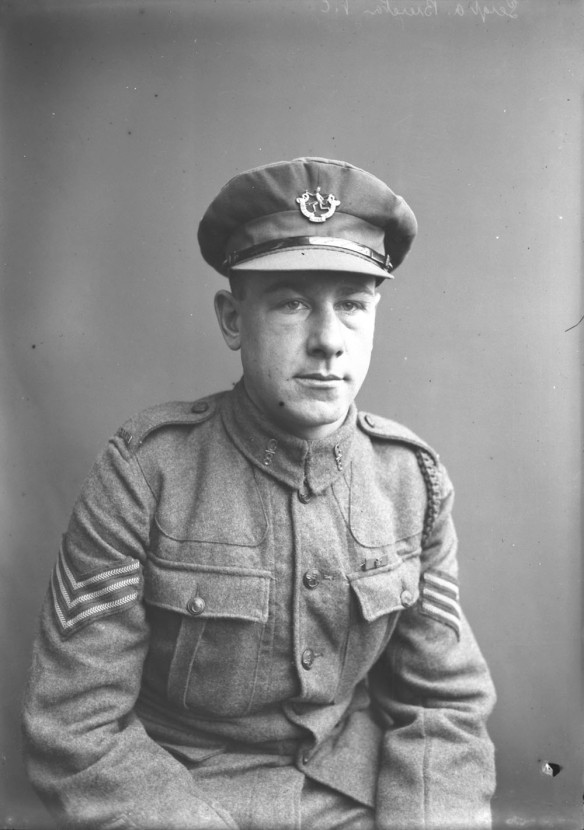By John Morden
Today we honour four Canadians who earned the Victoria Cross during the last campaign on the Western Front, known as the Hundred Days Offensive. They are Alexander Picton Brereton, Frederick George Coppins, John Bernard Croak and Raphael Louis Zengel.
Alexander Picton Brereton

Sergeant Alexander Picton Brereton, VC, 8th Battalion, undated (a006962)
Alexander Picton Brereton was born in Oak River, Manitoba, on November 13, 1892. Before enlisting in the 144th Battalion of the Canadian Expeditionary Force on January 31, 1916, Brereton worked as a barber and served in the militia. In April of 1917, he was transferred to the 8th Battalion. Brereton earned the Victoria Cross for his actions near Warvillers, France, on August 9, 1918. During an attack on German positions, Brereton and his men got caught in the open and were pinned down by heavy German machine-gun fire. With the most conspicuous bravery, realizing his unit faced certain destruction, Brereton single-handedly charged and captured a German machine-gun position. Brereton’s actions rallied his men to capture other German machine-gun nests. Brereton would survive the First World War and be discharged from the army on April 10, 1919. Brereton died on January 10, 1976, in Calgary, Alberta, where he was laid to rest in Elnora Cemetery.
Frederick George Coppins

Sergeant Frederick George Coppins, VC, undated (a006765)
Born on October 25, 1889, in London, England, Frederick George Coppins served in the Royal West Kent Regiment before immigrating to Canada. Coppins enlisted with the Canadian Expeditionary Force much earlier than other Canadian soldiers. He joined the 19th Alberta Dragoons on September 23, 1914. By the time of the final Allied drive to victory in the summer of 1918, Coppins was a hardened veteran. Coppins was promoted to Corporal and transferred to the 8th Battalion, the same unit as Brereton. Coppins earned the Victoria Cross on August 9, 1918. Much like Brereton, Coppins and his men were held up by German machine-gun fire. Realizing the situation at hand, Coppins gathered a handful of men to attack a German machine-gun post. During the attack, Coppins was wounded and the rest of the men were killed. Yet, Coppins persisted and captured the position, taking several enemy soldiers prisoner. Despite his wounds, Coppins stayed in the field of battle until the Canadian objectives were secured. Coppins would miraculously survive four years of service and be discharged from the army on April 30, 1919. He died on March 30, 1963, in Livermore, California, at the age of 73.
John Bernard Croak

Private John Bernard Croak, VC, undated Photo from Directorate of History and Heritage.
John Bernard Croak was born on May 18, 1892, in Little Bay, Newfoundland. He then moved with his family to Glace Bay, Nova Scotia. Before the outbreak of war in the summer of 1914, Croak worked as a labourer. Croak joined the Canadian Expeditionary Force on August 7, 1915, and was assigned to the 55th Battalion. In April of 1916, he was transferred to the 13th Battalion. Croak earned the Victoria Cross for his actions at the battle of Amiens on August 8, 1918. During the Canadian attack on that day, Croak became separated from his unit. He encountered a German machine position and, on his own, captured the entire gun crew. Although he was wounded later, he remained in the field. After reuniting with his unit, Croak came upon a position holding numerous German machine guns. In response to this threat, Croak, again on his own, charged the German position, soon to be followed by his comrades. The charge was successful, as they captured three machine guns and the German soldiers operating them. But Croak suffered severe wounds and died minutes later in an action that was “an inspiring example to all.” Croak’s final resting place is in Hangard Wood British Cemetery near the Somme in France.
Raphael Louis Zengel

Sergeant Raphael Louis Zengel, VC, 5th Battalion, 1914 (a006796)
Born in Faribault, Minnesota, on November 11, 1894, Raphael Louis Zengel was one of several American-born Victoria Cross recipients. As a young boy he moved with his mother to Plunkett, Saskatchewan. Before the war, Zengel worked as a farm labourer. In December of 1914, shortly after the outbreak of hostilities, Zengel enlisted in the 45th Battalion of the Canadian Expeditionary Force. He was later transferred to the 5th Battalion. On October 17, 1917, he was promoted to Sergeant.
Zengel earned the Victoria Cross on August 9, 1918, during the battle of Amiens. In that action, Zengel was leading his platoon in an attack when he noticed a gap had occurred on his flank. Under a hail of bullets from German machine-gun fire, Zengel charged ahead of his unit and captured the German machine-gun position. Later that day, a German shell knocked him unconscious. After coming to, Zengel continued to lead his men. His “work throughout the attack was excellent.” Though wounded in September, Zengel would live to see the end of the war on his 24th birthday and his discharge from the army on April 24, 1919. On February 27, 1977, at the age of 82, Zengel died in Errington, British Columbia.
Library and Archives Canada holds the digitized service files of Brereton, Coppins, Croak and Zengel.
John Morden is an honours history student from Carleton University doing a practicum in the Online Content Division at Library and Archives Canada.
